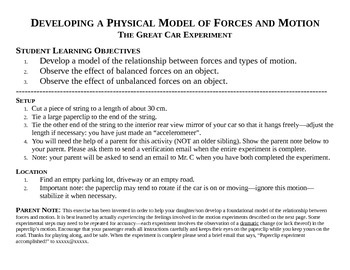STEM/NGSS: Physics Lab-- Developing A Physical Model of Forces and Motion
Next Generation Science Guy
86 Followers
Grade Levels
7th - 12th, Homeschool
Subjects
Resource Type
Standards
NGSSMS-PS2-2
NGSSMS-PS2-1
Formats Included
- Word Document File
Pages
4 pages
Next Generation Science Guy
86 Followers
Description
The student conducts 5 experiments involving a paperclip hanging by a string to their rearview mirror. Safely in tow with a parent, the student analyzes similarities and differences between the behavior of the dangling clip. The student learns that balanced forces result in no dramatic change in the clip. The student learns that unbalanced forces result in acceleration, and therefore dramatic change.
Total Pages
4 pages
Answer Key
Not Included
Teaching Duration
90 minutes
Report this resource to TPT
Reported resources will be reviewed by our team. Report this resource to let us know if this resource violates TPT’s content guidelines.
Standards
to see state-specific standards (only available in the US).
NGSSMS-PS2-2
Plan an investigation to provide evidence that the change in an object’s motion depends on the sum of the forces on the object and the mass of the object. Emphasis is on balanced (Newton’s First Law) and unbalanced forces in a system, qualitative comparisons of forces, mass and changes in motion (Newton’s Second Law), frame of reference, and specification of units. Assessment is limited to forces and changes in motion in one-dimension in an inertial reference frame, and to change in one variable at a time. Assessment does not include the use of trigonometry.
NGSSMS-PS2-1
Apply Newton’s Third Law to design a solution to a problem involving the motion of two colliding objects. Examples of practical problems could include the impact of collisions between two cars, between a car and stationary objects, and between a meteor and a space vehicle. Assessment is limited to vertical or horizontal interactions in one dimension.





